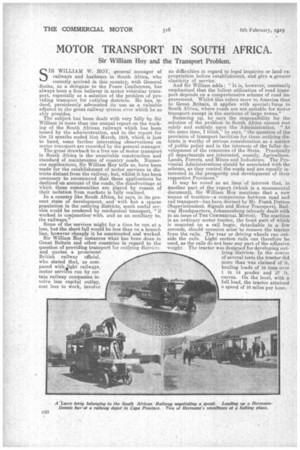MOTOR TRANSPORT IN SOUTH AFRICA.
Page 10

If you've noticed an error in this article please click here to report it so we can fix it.
Sir William Hoy and the Transport Problem.
SIR WILLIAM W. ROY, general manager of railways and harbours in South Africa, who recently arrived in this country, with General -Botha, as a delegate to the Peace Conference, has always been a firm believer in motor vehicular transport, especially as a solution of the problem of providing transport for outlying districts. He has, indeed, persistently advocated its use as a valuable adjunct to the great railway system Over which he so
ably presides. ,
The subject has been dealt with very fully by Sir William in more than one annual report on the working of the South African railways which has been issued by the administration, and in the report for the 15 months ended 31st March, 1918, which is just to hand, some further interesting observations on moter transport are recorded by the general manager. The great drawback to a free use of motor transport in South Africa is the unsuitable construction and standard of maintenance of country roads. Numerous applications, Sir William Hoy tolls us, have been made for the establishment of motor services, in districts distant from the railway, but, whilst it has been necessary to recommend that these applications be declined on account of the roads, the disadvantage at which these communities are placed by reason of their isolation from markets is fully realized.
In a country like South Africa, he says, in its present state of development, and with but a sparse population in the outlying districts, much useful service could be rendered by mechanical transport, "if worked in conjunction' with, and as an auxiliary to, the railways." Some of the services might for a time be run at a loss, but the short fall would be less than on a branch line, however cheaply it be constructed and worked. Sir William Hoy instances what has been done in Great Britain and other countries in regard to the question of providing transport for outlying dist ri( and quotes a prominent British railway official, who stated that, as compared with jight railways, motor serviFes run by certain railway companies involve less capital outlay, cost less to work, involve no difficulties in regard to legal inquiries or land expropriation before establishment, and give a greater elasticity of service. And Sir William adds : "It is, however, constantly emphasized that the fullest utilization of road transport depends on a comprehensive scheme of road improvement. Whilst this refers more to, America than. to Great Britain, it applies with .speciali force to South Africa, where roads are not suitable for motor transport except in the environs of large towns."
Summing up, he says the responsibility for the solution of the problem in South Africa cannot rest solely and entirely upon the Administration. "At the same time, I think," he says, "the question of the provision of transport facilities for these outlying districts is worthy of serious consideration as a matter of public policy and in the interests of the fuller development of the resources of the State. Practically all departments are jnterested, namely, Agriculture, Lands, Forests, and Mines and Industries. The Provincial Administrations should be associated with the scheme, as they control the roads and are equally interested in the prosperity and development of their respective Provinces."
It may be noted as an item of interest that, in another part of the report (which is a monumental document), Sir William Hoy mentions that a new means of traction—a compromise betWeen road and rail transport—ha-s been devised by Mr. Frank Dutton (Superintendent, Signals and Motor Transport), Railway Headquarters, Johannesburg (already dealt with in an issue of TEE COMMERCIAL MOTOR). The machine is an ordinary motor tractor, the front part of which is mounted on a rail bogie, detachable in a few seconds should occasion arise to remove the tractor from this rails. The rear or driving wheels run outside the rails. Light section rails, can therefore be used, as the rails do not bear any part of the adhesive weight The tractor was desisned for developing outlying districts. In the course of several tests the tractor did more than was claimed of it, hauling loads of 16 tons over 1 in 14 grades and 37 ft. curves. On the level, with a full load, the tractor attained a speed of 16 miles per hour.






















